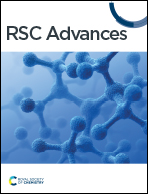The quantitative pyrrole protection of l-phenylalanine/l-phenylalaninol in aqueous media and rationally updating the mechanisms of the Clauson-Kaas reaction through DFT study†
Abstract
The classical Paal–Knorr reaction is a prominent tool that can be adopted under biocompatible conditions covering various γ-dicarbonyls for either chemical biology or drug discovery. Meanwhile, the relatively mild conditions for larger molecules within biological systems have not been employed to obtain N-substituted pyrrole derivatives from simpler chiral amino acids/alcohols. The Clauson-Kaas methodology of a standard two-phase acidic mixture buffered with acetate salts was generally required for the time-consuming catalytic condensation of 2,5-dimethoxytetrahydrofuran and fast removal of pyrrolyl products after formation to inhibit their racemization. To achieve a large amount of tethered pyrrole pendants based on L-phenylalanine to construct bioactive ureas as ASK1 and PI3K inhibitors, one quick and highly efficient protocol was realized in an almost neutral and benign aqueous condition. This protocol proceeds within only 15 minutes at 90 °C, achieving nearly quantitative conversion to the final pyrrolyl product via convenient and facile column-free purification. The detailed mechanistic studies by DFT method proposed a new series involving the pathway by the initiation of a zwitterionic species/intermediate for a subsequently much more efficient self-driven pyrrole-formation. This was inconsistent with the traditional kinetic modelling of ring opening to furnish a carbocation, or the utilization of succinaldehyde/dihydroxytetrahydrofuran as a dialdehyde synthetic equivalent. In addition to the relationally neighbouring intramolecular catalytic effect from the amino acid, the crucial “H-bridge” interplay of water, along with the suggestion of a biomimetic route features similar to the N-glycosylation of carbohydrates, probably indicates the totally different reaction courses. The auto-catalysis ability of L-phenylalanine was also extensively investigated by comparisons on the details relating to L-phenylalaninol.



 Please wait while we load your content...
Please wait while we load your content...